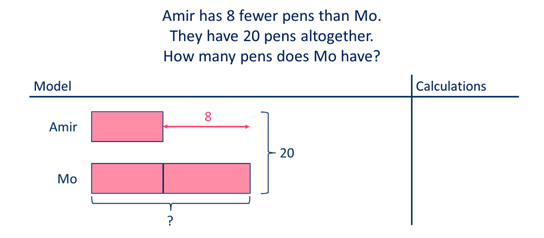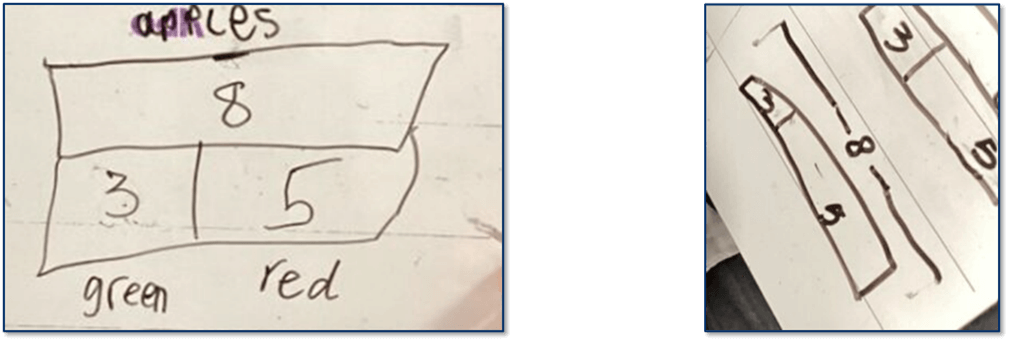Exploring Bar Model Illustration Techniques: A Comprehensive Guide to Envisioning Math Concepts
Bar version drawing methods work as a useful resource for both teachers and pupils in visualizing mathematical principles. These models streamline intricate numerical partnerships, aiding in the comprehension of enhancement, department, reproduction, and reduction. This overview describes effective techniques for implementing bar versions, fostering active interaction and real-world links. As viewers discover the sensible applications and teaching tips, they will reveal how these techniques can change their method to mathematics.
Understanding the Basics of Bar Model Illustration
Bar design drawing works as an effective aesthetic tool in maths, promoting the understanding of analytic strategies and mathematical relationships. This method includes representing numbers and their relationships via rectangle-shaped bars, making it much easier to picture operations such as addition, subtraction, reproduction, and department. Each bar's size matches to a specific worth, permitting learners to contrast quantities and comprehend proportions clearly.
To develop a bar design, one starts by recognizing the issue's crucial elements, often simplifying into parts that can be aesthetically stood for. In an easy enhancement trouble, 2 bars can be drawn, with their sizes standing for the addends. The consolidated size highlights the sum. Furthermore, bar models can be adapted for extra intricate problems, including proportions and fractions, by adjusting benches appropriately. Mastering these fundamentals lays a solid foundation for effective analytic and much deeper mathematical comprehension.
Benefits of Utilizing Bar Models in Math
Utilizing bar versions in mathematics supplies many advantages that boost discovering and comprehension. These graphes help trainees in comprehending complicated concepts by damaging them down right into workable parts. Bar designs provide a clear structure for showing connections between numbers, making abstract concepts a lot more concrete. They advertise a much deeper understanding of mathematical operations and assist in analytic by enabling students to imagine the information they are dealing with.
Bar models support the development of important believing skills, as students must analyze and translate the visual information to draw final thoughts. This approach urges energetic involvement with the material, reinforcing retention and proficiency of mathematical concepts. By promoting a solid foundation in aesthetic literacy, bar designs encourage students to approach various mathematical challenges with confidence. Generally, the assimilation of bar designs into mathematics education shows beneficial in growing both understanding and analytical abilities amongst pupils.
Applying Bar Versions to Enhancement and Subtraction
Bar models offer as an efficient tool for visually standing for enhancement and reduction issues. By showing the relationship in between numbers, they boost understanding and promote analytical. Furthermore, real-life applications of these versions can help students understand mathematical concepts in practical contexts.
Standing For Addition Visually
Aesthetic aids can significantly boost their understanding of these procedures when trainees encounter enhancement and subtraction issues. Bar models act as efficient devices for representing enhancement. By splitting a rectangle into sections that correspond to the numbers involved, pupils can visualize the connection between the amounts. If a student needs to include 3 and 5, they can create a bar separated right into 2 areas: one section standing for 3 and the various other standing for 5. This clear representation not only streamlines the enhancement procedure but likewise reinforces the idea of integrating amounts. As students adjust these visual aids, they establish a deeper understanding of enhancement, causing boosted analytic abilities and better confidence in their mathematical abilities.
Subtraction With Bar Versions
Although subtraction is frequently regarded as an extra intricate operation than addition, bar designs can efficiently clarify this procedure for trainees. By aesthetically representing the quantities involved, trainees can better understand how numbers connect to each other. In a bar model for reduction, one bar stands for the overall, while an additional suggests the quantity being subtracted. This aesthetic difference assists students grasp the concept of "taking away." For instance, if a bar shows 10 units, and another bar standing for 4 systems is removed, students can quickly see that 6 systems remain. This technique not only fosters understanding of reduction yet likewise aids in creating analytical skills, permitting pupils to picture their mathematical reasoning and boost their total understanding of mathematical concepts.
Real-Life Application Examples
Comprehending subtraction with bar models lays a foundation for using these methods in real-life situations. In different contexts, such as budgeting or buying, individuals can imagine just how much money stays after expenses. If a person has $50 and invests $20, a bar design can represent the overall quantity and the spent part, illustrating that $30 is left. In addition, parents can use bar designs to assist youngsters recognize the amount of even more items require to be included in complete a collection, such as having 3 apples and requiring five. This aesthetic depiction streamlines complicated problems, assisting in understanding and retention. Ultimately, bar models serve as effective devices in daily decision-making, boosting mathematical understanding in practical situations.
Imagining Reproduction and Department With Bar Designs
In checking out the application of bar models for multiplication and department, it is important to realize their foundational concepts. Building reproduction designs allows students to picture partnerships in between numbers, while effective department strategies can be illustrated with these visual aids. This strategy boosts understanding and analytic abilities in maths.
Recognizing Bar Versions
Bar versions function as an effective aesthetic device for highlighting the concepts of multiplication and department. They enable students to stand for mathematical partnerships in an organized format, helping with a much deeper understanding of these procedures. In multiplication, bar versions display groups of equal dimension, allowing people to visualize the total amount when combining these groups. On the other hand, in department, bar versions assist portray how a total amount is split into smaller sized, equivalent parts, making clear the idea of partitioning. By using these visual help, pupils can comprehend the underlying concepts of multiplication and division much more effectively. This method not just improves understanding but also sustains analytical skills, making bar versions an indispensable property in mathematical education and learning.
Constructing Multiplication Designs
Constructing reproduction versions making use of bar representations provides a clear approach for envisioning the process of reproduction. These models make it possible for learners to stand for multiplication as teams of equivalent parts, making abstract principles much more concrete. As an example, to show (3 times 4), a pupil can draw one bar split right into three equivalent segments, each standing for 4 systems. Additionally, producing a 2nd bar with the exact same size reinforces the understanding of repeated enhancement, as each sector corresponds to one group. This graph not only help in realizing reproduction however additionally enhances analytical skills. By using bar versions, trainees can much better comprehend connections between numbers and create a robust foundation for more intricate mathematical ideas, leading to raised self-confidence in their capacities.
Envisioning Division Approaches

Fixing Word Troubles Making Use Of Bar Design Techniques

As an example, in a problem involving enhancement and subtraction, pupils can attract different bars for each quantity and afterwards adjust them to discover the option. This process not just makes clear the trouble yet likewise fosters a much deeper theoretical understanding. In addition, bar versions can be adjusted for different kinds of word problems, making them flexible across different mathematical subjects. Inevitably, making use of bar versions can substantially boost trainees' analytic abilities by providing a clear visual path to get here at the proper response.
Integrating Bar Models in Different Mathematics Topics
Bar designs can be effortlessly incorporated right into different mathematics subjects, enhancing students' understanding of principles beyond basic arithmetic. In algebra, these visual devices help in representing inequalities and formulas, enabling students to imagine relationships between variables. When taking on geometry, bar versions can show the properties of shapes and spatial thinking, assisting trainees realize concepts like location and perimeter successfully. In statistics, bar versions help with the analysis of data collections, allowing students to contrast quantities and acknowledge patterns visually. Furthermore, integrating bar versions within dimension subjects aids in comprehending devices and conversions by offering a substantial representation of quantities. By using bar versions throughout various mathematical locations, instructors can promote a deeper comprehension of complicated ideas, therefore enhancing problem-solving abilities and advertising important reasoning (bar model drawing techniques). This convenience demonstrates the utility of bar models as a foundational tool for students in their mathematical trip
Tips for Mentor Bar Designs Successfully
Incorporating bar models into training techniques requires thoughtful methods to maximize their efficiency. Educators ought to begin by introducing bar designs with simple, relatable instances that trainees can conveniently comprehend. This aids to develop confidence and knowledge with the principle. Gradually enhancing the intricacy of troubles allows learners to apply their abilities progressively. In addition, teachers should urge pupils to develop their own bar versions, advertising active involvement and possession of their learning.
Including collaborative tasks can likewise improve understanding, as trainees review and resolve troubles in groups. Continuous responses is vital; teachers must give positive discourse on students' bar version depictions to lead enhancement. Connecting bar models to real-life circumstances strengthens their significance, aiding pupils see the useful applications of their mathematical abilities. By carrying out these approaches, teachers can effectively harness the power of bar versions in their mathematics guideline.
Often Asked Inquiries
Can Prevent Models Be Made Use Of in Other Subjects Besides Math?
Bar versions can undoubtedly be more info used in numerous subjects past math. They efficiently highlight principles in scientific research, social researches, and language arts, helping to aesthetically represent connections, procedures, and concepts for improved understanding across techniques.
What Age Is Ideal Suited for Discovering Bar Designs?
Bar models are best fit for youngsters ages 7 to 12, as they create concrete reasoning skills throughout this duration (bar model drawing techniques). At this age, pupils can efficiently grasp abstract concepts through graph and problem-solving techniques
Are There Digital Tools for Creating Bar Versions?

How Can I Analyze Pupil Understanding of Bar Designs?
Evaluating pupil understanding of bar models can involve tests, empirical assessments, and seminar. Teachers may also analyze trainees' finished versions and their ability to discuss their reasoning, ensuring a detailed examination of understanding.
What Are Typical Errors When Using Bar Models?
Typical errors when utilizing bar versions consist of misrepresenting quantities, stopping working to properly identify bars, puzzling enhancement and reduction, overlooking to make use of consistent scales, and forgeting the value of clear aesthetic separation between different aspects.
In enhancement, bar designs can be adjusted for extra complicated problems, consisting of fractions and ratios, by adjusting the bars accordingly. Subtraction is usually viewed as an extra complicated operation than addition, bar versions can successfully clarify this process for trainees. In a bar design for reduction, one bar represents the total, while one more indicates the quantity being subtracted. If a bar reveals 10 systems, and another bar standing for 4 systems is removed, students can easily see that 6 devices remain. When splitting a total right into equal groups, trainees can attract a lengthy bar to stand for the entire and after that sector it into smaller sized bars that suggest each group.